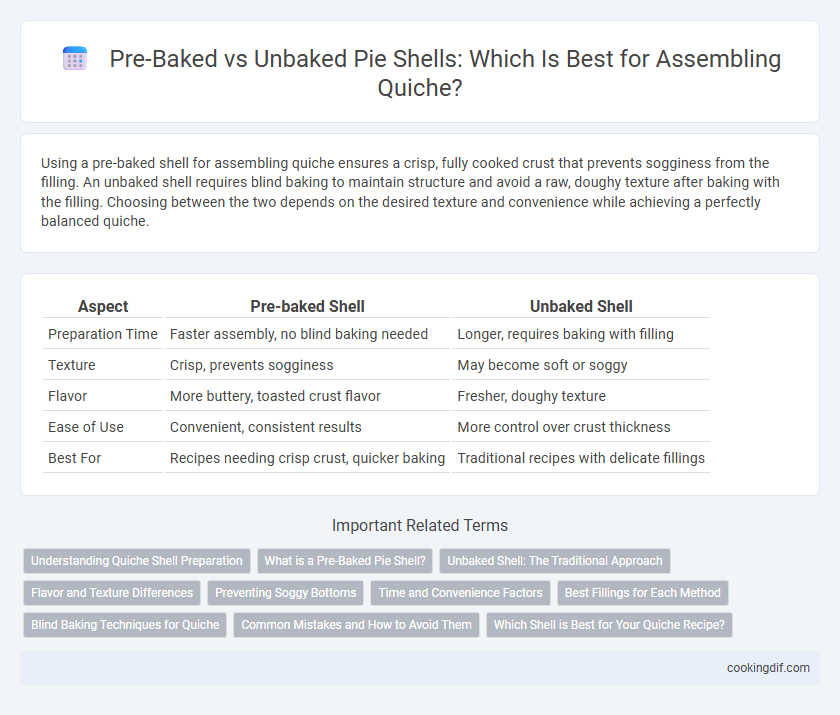Using a pre-baked shell for assembling quiche ensures a crisp, fully cooked crust that prevents sogginess from the filling. An unbaked shell requires blind baking to maintain structure and avoid a raw, doughy texture after baking with the filling. Choosing between the two depends on the desired texture and convenience while achieving a perfectly balanced quiche.
Table of Comparison
| Aspect | Pre-baked Shell | Unbaked Shell |
|---|---|---|
| Preparation Time | Faster assembly, no blind baking needed | Longer, requires baking with filling |
| Texture | Crisp, prevents sogginess | May become soft or soggy |
| Flavor | More buttery, toasted crust flavor | Fresher, doughy texture |
| Ease of Use | Convenient, consistent results | More control over crust thickness |
| Best For | Recipes needing crisp crust, quicker baking | Traditional recipes with delicate fillings |
Understanding Quiche Shell Preparation
Pre-baked shells, also known as blind-baked shells, provide a crisp and firm base that prevents the quiche filling from becoming soggy by sealing the dough before adding wet ingredients. Unbaked shells allow the crust to bake simultaneously with the filling, resulting in a softer, more tender texture but may risk a less structured crust if the filling is particularly moist. Choosing between pre-baked and unbaked shells depends on the desired balance between crust texture and the moisture content of the quiche filling.
What is a Pre-Baked Pie Shell?
A pre-baked pie shell, also called a blind-baked crust, is a pie crust that has been partially or fully baked before adding the quiche filling. This technique prevents the crust from becoming soggy by creating a firm base that holds the custard and ingredients without absorbing excess moisture. Pre-baking is essential for quiches with wet fillings, ensuring a crisp, golden crust and a perfectly textured final dish.
Unbaked Shell: The Traditional Approach
Using an unbaked shell for quiche preserves the crust's tender, buttery texture as it bakes simultaneously with the filling, allowing the dough to absorb flavors and moisture. This traditional method ensures a harmonious blend between the crisp pastry and creamy custard, preventing over-browning or toughness that can occur with pre-baked shells. Quiche recipes often recommend unbaked shells to achieve an authentic texture and rich taste characteristic of classic French cuisine.
Flavor and Texture Differences
Using a pre-baked shell for quiche produces a crisp, golden crust that maintains its shape and prevents sogginess, enriching flavor with a toasted, buttery note. In contrast, assembling quiche in an unbaked shell allows the pastry to absorb moisture from the filling, resulting in a softer, more tender crust that integrates flavors more harmoniously. Pre-baking enhances texture contrast between crust and filling, while unbaked shells promote a cohesive, melt-in-the-mouth consistency.
Preventing Soggy Bottoms
Using a pre-baked shell for quiche creates a firm, crisp barrier that helps prevent soggy bottoms by sealing the crust before adding the filling. An unbaked shell absorbs moisture from the custard and vegetables, often resulting in a wet, limp base. For optimal texture and structural integrity, blind baking the shell at 375degF for 15 minutes is recommended.
Time and Convenience Factors
Using a pre-baked shell for assembling quiche significantly reduces preparation time by eliminating the need for blind baking, allowing immediate filling and baking. Unbaked shells require careful blind baking to prevent sogginess, adding extra steps and time to the process but offering a crisper crust texture. Choosing between pre-baked and unbaked shells depends on prioritizing convenience and speed versus achieving optimal crust texture.
Best Fillings for Each Method
Pre-baked quiche shells provide a crisp, buttery base ideal for custard-heavy fillings like classic Lorraine with bacon and cheese, or creamy spinach and mushroom mixtures, preventing sogginess. Unbaked shells excel with moist, vegetable-rich fillings such as zucchini, tomatoes, or caramelized onions that release liquid during baking, allowing the crust to absorb flavors and stay tender. Selecting the right shell preparation maximizes texture and taste by complementing the moisture content and richness of the quiche filling.
Blind Baking Techniques for Quiche
Using a pre-baked shell for quiche ensures a crisp, golden crust by preventing sogginess from the custard filling. Blind baking involves lining the dough with parchment paper and filling it with pie weights or dried beans to maintain shape during baking. Unbaked shells require longer baking times with fillings but risk a soggy base, making blind baking essential for achieving the perfect texture.
Common Mistakes and How to Avoid Them
Using an unbaked shell for quiche often results in a soggy crust due to the high moisture content of the filling, a common mistake among home cooks. To avoid this, blind bake the shell at 375degF for 15 minutes with pie weights to ensure a crisp, golden base. Proper pre-baking prevents sogginess and guarantees a flaky, sturdy crust that holds the custard filling perfectly.
Which Shell is Best for Your Quiche Recipe?
Using a pre-baked shell for quiche ensures a crisp, fully cooked crust that prevents sogginess when filled with custard and ingredients. An unbaked shell allows the dough to bake alongside the filling, creating a more cohesive texture but requires careful baking time adjustment to avoid undercooked crust or overdone filling. Choosing the best shell depends on the recipe's moisture content and desired crust texture, with pre-baked shells preferred for wetter fillings and unbaked shells suited for drier, thicker quiches.
Pre-baked shell vs unbaked shell for assembling quiche Infographic

 cookingdif.com
cookingdif.com